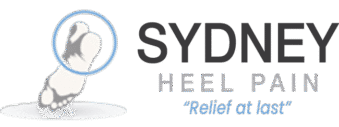Case Study – Tight Calf Muscles – The Cause of Plantar Fasciitis and Achilles Tendonitis
Plantar Fasciitis and Achilles Tendonitis
Two of the most common conditions that we treat at the Sydney Heel Pain clinics are plantar fasciitis and Achilles tendonitis. These two conditions seem to affect people from all walks of life. While our typical patient is a female aged in the latter half of her life, these conditions affect men and women, both young and old. There are several contributing factors to consider when looking at the cause plantar fasciitis. Interestingly, the contributing factors that are commonly associated with this heel pain condition, are also associated with Achilles tendonitis. It is true that there is no one singular cause of either of these conditions, but calf muscle issues occur time and time again.
Case Study – December 2017
A 55 year old female presents to the Sydney heel pain clinic complaining of plantar fasciitis of approximately 3 months. She reports classic symptoms, such as pain under the ball of her heel which is very prominent first thing in the morning when she begins to walk. She describes pain after being seated and also pain whilst driving for long distances. She informs the podiatrist that when she stands up to walk from a seated position, the pain under the base of her heel causes her to limp somewhat. She informs the podiatrist that she has never had plantar fasciitis before but did experience Achilles tendonitis in the same leg approximately 18 months ago. Since developing plantar fasciitis, this patient has reduced her level of activity due to the pain. Ordinarily she would walk each morning with her husband for approximately 7 km. She would also enjoy weekly sessions of Zumba. She advises that she feels extreme pain the evening of a Zumba class, and an increase in symptoms the following morning. She has not engaged in any treatment for the plantar fasciitis but has been rolling her foot on a Frozen bottle at home.
She describes temporary relief from the heel pain following the rolling on the bottle, but that the relief is short-lived. She reports to the podiatrist that her Achilles tendon on the same leg is starting to feel stiff, and similar to how it felt when she developed Achilles tendonitis. She is adamant that she wants to treat this problem as soon as possible, as she does not want to experience the pain that she experienced 18 months ago from the Achilles tendonitis. The sports podiatrist advised the patient that both plantar fasciitis and Achilles tendonitis are very common problems in the clinic, and that both of them are treatable. She was reassured that she will make a full recovery, but that improvement of these conditions can sometimes be quite slow.
Sydney Heel Pain Mobile Application
Firstly, the podiatrist installs the Sydney heel Pain mobile app onto the patient’s smartphone, so that she has clear instructions on the treatment of the plantar fasciitis. The mobile app contains information, including but not limited to, a range of home remedies that can aggravate or assist with the problem. She is advised to “wipe the slate clean” and cease all home remedies, even if they provide short term relief of her plantar fasciitis. She’s advised that some of these home remedies can create short term pain relief but can aggravate the condition long term. The mobile phone application also contains information surrounding the successful treatment of Achilles tendonitis. The app contains diagrams and instructions pertaining to calf stretching technique. When treating plantar fasciitis footwear selection is also crucial and the app contains a page of information surrounding footwear. Specific shoe models are also included.
Physical Examination for Plantar Fasciitis
Pressure was applied to the base of the heel around the attachment of the plantar fascia. The patient confirmed pain. The podiatrist also applied pressure to the medial slip of the plantar fascia from the base of the heel and into the arch of the foot. Mild pain was also present in these areas. The sports podiatrist confirmed that the patient was presenting with all the classic signs and symptoms of plantar fasciitis.
Further examination was carried out in order to determine the cause of the plantar fasciitis. One of the most striking, but not surprising findings, was an extreme tightness in both calf muscles. As mentioned above, restricted range of motion through the calf muscles is one of the most common causes of plantar fasciitis and Achilles tendonitis. The tightness increases the pulling sensation through the Achilles tendon and furthermore increases the pulling of the heel bone away from the plantar fascia. The patient was advised that her calf muscles were probably the likely source of her problem, and that this same biomechanical anomaly was more than likely the cause of her Achilles tendonitis that she experienced 18 months ago.
Treatment – One Stretch Treats All
In addition to the information contained in the mobile phone application, the podiatrist pointed out to the patient that one of the most important things that she needed to do in order to get on top of her plantar fasciitis, was perform regular and specific calf stretches. She was advised that the tightness in her Achilles tendon would also improve following this stretching program. This would significantly reduce the likelihood of an Achilles tendonitis recurrence. The podiatrist performed the stretches and the patient observed. Roles were reversed. The patient performed the stretches and the podiatrist observed and made small adjustments. Stretching technique, frequency of stretches, and number of stretches per session were all outlined in the mobile phone application. A diagram was also pointed out in the mobile phone application. The patient performed the stretches well and felt confident and happy with the technique. She understood and committed to the footwear changes and the specific information contained in the app.
This patient had done some research and requested shock wave therapy treatment. The podiatrist denied, but informed the patient that if she did not feel any improvement with the current treatment plan that had been put in place, then he would commence shockwave therapy at a later date. The patient returned after 4 weeks and reported significant improvement. She informed the podiatrist that the plantar fasciitis had all but subsided and that she did not fear a recurrence of the Achilles tendonitis, as her calf range and Achilles tendon felt free. The patient was advised to continue with the same treatment plan, with no modifications, until her pain had completely subsided. She was informed to return to the clinic if her plantar fasciitis deteriorated or if she felt a recurrence of the Achilles tendonitis. No further appointments were taken.
Please note that the information contained in this case study relates to one particular individual. This case study should not be taken as general advice. If you think you have plantar fasciitis or Achilles tendonitis you should seek the help of a suitably qualified sports podiatrist.
Written by Karl Lockett





